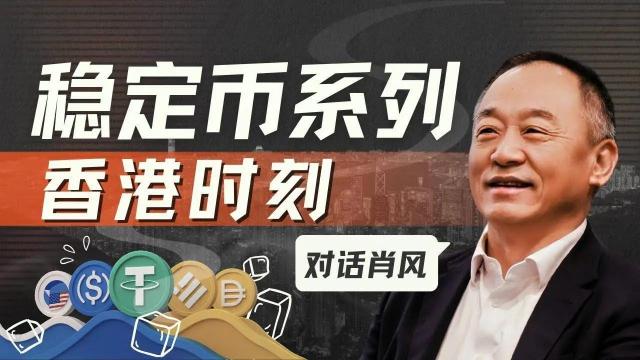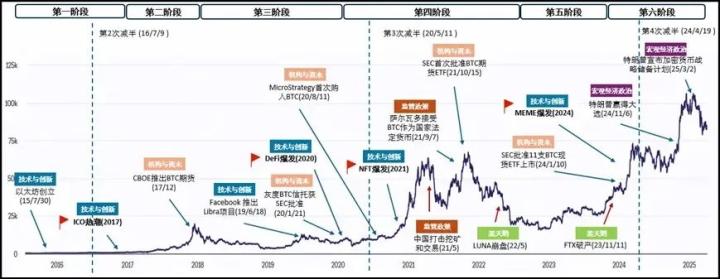Title: 'Stablecoins Are Now Legit, but That's Only the First Step – Bits + Bips'
Host: Steve Ehrlich, Chief Contributor of Unchained Kingdom; Noelle Atchison, Editor-in-Chief and Chief Analyst of 'Crypto is Macro Now'
Guests: Ram Alawalia, Head of Wealth Management at Lumida; CosmoJiang, Senior Trader and Liquid Strategy Portfolio Manager at Pantera Liquid Vault
Podcast Date: July 24, 2025
Organized & Translated by: LenaXin, ChainCatcher
ChainCatcher Editor's Summary
This article is compiled from the Unchained podcast column Bits + Bips. With the passage of the GENIUS Act and Stablecoin Act, the United States has established a clear regulatory framework for stablecoins for the first time.
Why does Noelle say the Stablecoin Act is just the beginning? What does the latest rebound of Ethereum mean, and what is its essence? How does Trump's threat to fire Powell shake macro sentiment?
This episode will discuss topics including Ethereum price increases, interpretation of the GENIUS Act, Federal Reserve independence, and the rise of emerging crypto asset management companies.
Compiled and translated by ChainCatcher.
Key Points Summary
... [rest of the text continues in the same manner]This confirms the "shovel seller" theory: just like in the gold rush, the tool merchants made the most money, in the stablecoin wave, infrastructure providers (such as Paxos) offering technical solutions for trading platforms may be more stable than issuers.
Steve: Are you referring to the regulatory issues Paxos encountered when previously collaborating with Binance to issue BUSD?
Ram: To be precise, USDG is the stablecoin token they are currently issuing.
Noelle: Wallet service providers will encounter important development opportunities. The core pain point of user experience is the interoperability between different stablecoins. This is precisely the key link that wallet design can solve.
What Does the Latest ETH Rebound Mean
Steve: How do you all view Ethereum's significant increase?
Cosmo: The ETH/BTC exchange rate has nearly doubled in two months, reflecting a major change in market expectations. Large-scale purchases by digital asset custody institutions have become the primary driving force, with the core logic being that Ethereum will become the infrastructure layer of the stablecoin ecosystem.
Steve: Ethereum is still in the expansion process. What does this mean for listeners evaluating different ETH investment channels? How should one choose between leveraged ETF and crypto asset management companies?
Cosmo: Although core issues like Ethereum's economic model still exist, several key changes are happening:
1. Organizational Culture Innovation
The long-standing efficiency issues of the Ethereum Foundation are changing
The organizational culture transformation promoted by new director Tomas has been significantly effective
The interaction mode with venture capital, DeFi protocols, and traditional financial institutions has fundamentally transformed
2. Improved Regulatory Environment
Stablecoin legislation provides certainty for the industry
Milestone events like Circle's listing enhance the credibility of the asset class
Ethereum's value capture capability as underlying infrastructure has increased
These changes constitute a substantial improvement in fundamentals. The positive cycle currently experienced by the Ethereum ecosystem is a typical characteristic of fundamental qualitative change.
Noelle: There is still a cognitive gap in the crypto field. New investors only start paying attention when policy implementation becomes news, and the market is far from fully priced. The current progress of national debt allocation strategy has not been fully digested.
Ram: This involves two dimensions of policy orientation and personal influence. Stablecoin policies are bringing structural changes that significantly benefit Ethereum.
There is an interesting paradox in market operation mechanisms: the more decentralized a system is, the more it needs centralized market leadership. The current market volume insufficiency faced by Ethereum is precisely related to Vitalik's relatively low-key public image. In contrast, the Solana camp, with people like Kyle Samani, deeply understands the art of meme propagation.
Steve: How will this round of ETH trend conclude? Current market bubble signs are obvious, and FOMO sentiment is spreading. How should investors respond?
Cosmo: The core issue is how to define the "others" in the crypto market. Currently, native crypto capital has been fully deployed, and traditional financial capital, though slow to enter, has shown signs. This makes me confident in my positions, but the true allocation wave still needs to wait.
What is the Essence of the Surge in Digital Asset Financial Companies
Steve: As the head of Pantera's crypto asset management business, can you share your market observations?
Cosmo: We focus on innovative projects. Take DFTV, a national debt company on the Solana chain, as an example. Its pioneering value was quickly verified by the market, with institutions like Tether and Cantor subsequently launching similar products. This field is experiencing explosive growth.
Although the industry will undergo survival of the fittest, we continue to increase investment. Witnessing the birth of an entirely new enterprise category is a rare investment opportunity.
Steve: How to identify truly high-quality investment targets? What key factors do you rely on when reviewing numerous financing proposals?
Cosmo: The business model must first be verified for sustainability. The current market already shows obvious homogeneous competition, and the industry is experiencing commoditization.
The key to success lies in scale effects, which require the token itself to have:
1) Sufficient market value (usually needing to rank among the top 10-15)
2) Mainstream market awareness
3) Clear value proposition
Execution capability is the decisive factor. The team needs to possess both native crypto marketing capabilities and traditional financial instrument application abilities.
Ram: As a cross-asset investor, we've noticed market fatigue signals. Cryptocurrency's seasonal characteristics are particularly prominent, and next month coincides with Bitcoin's traditional weak cycle.
Digital asset prices depend more on market momentum than fundamental indicators. The current "upward trend self-reinforcement" mechanism is weakening, suggesting that momentum-driven market trends may be facing a turning point.
(Note: The "ramjet engine" effect explains the mechanism of self-reinforcing upward trends)
Can the Crypto Company IPO Wave Match Early Successes
Noelle: Many crypto giants have recently submitted IPO applications. Does this mean market heat in the second half of the year will be less than in the first half?
Ram: The trend of numerous crypto asset management companies emerging continues. However, with the increase in similar projects, market attention is dispersing, making it harder for investors to focus on industry leaders.
Noelle: The phenomenon of crypto companies like BitGo, Grayscale, and Bullish clustering for IPOs is worth noting. How long will this enthusiasm last?
Ram: The market still has investment enthusiasm, but valuation systems are clearly differentiated. Some private projects are valued at only 35% of their listed peers, while Coinbase's P/E ratio reaches 60 times. More IPO cases are expected in the fourth quarter.
Noelle: After the inflated valuations in 2021, VC funding suddenly dried up. Cosmo, have you observed signs of VC activity rebounding?
Cosmo: Market funds are showing polarization. Coinbase's 60-times P/E ratio benchmark makes Pre-IPO rounds more attractive. Seed rounds and early investments remain active, but A-C rounds in intermediate stages are relatively cold.
Steve: Despite optimistic narratives, why is venture capital activity still lagging?
Cosmo: The public market naturally accommodates many "qualified" enterprises. Taking asset management as an example, investment portfolios will necessarily allocate multiple crypto trading platforms, just with different weights.
How Trump's Threat to Fire Powell Shakes Macro Sentiment
Steve: What are your thoughts, Noelle, on whether Trump will fire Powell? With earnings season approaching, can you briefly share the focus and analysis points?
Noelle: Current macro data meets expectations, and there's insufficient reason for rate cuts. This week, housing data will be the focus.
Tariff policy impacts are evident, with prices of affected categories rising significantly. Trump's threat to fire Powell is worth being vigilant about, as it substantially weakens the Federal Reserve's independence.
Damage to the Federal Reserve's independence will lead to long-term inflation deterioration. The possibility of rate cuts this year is basically excluded, and Powell must defend policy independence.
Steve: Even if Trump replaces Federal Reserve board members, will the new appointees submit to presidential will? Will other members maintain an independent stance?
Noelle: Fed policy depends on collective decisions. The current FOMC median view is relatively hard-line, and Trump can at most replace two seats. The key lies in the Federal Reserve's tradition of independence. Committee members will resist political pressure.
It's necessary to distinguish inflation driving factors: tariff impacts are one-time effects, and the real risk is fiscal imbalance.
Steve: This week's EU-China summit, with von der Leyen visiting Beijing next week. If unable to export to the US, Beijing might turn to dumping in the European market. What are your expectations?
Noelle: The originally EU-hosted meeting was forced to adjust under China's counter-invitation, with the agenda compressed to one day, putting the European delegation in a passive position.
Tensions stem from recent inappropriate EU remarks about China, exposing its strategic dilemma. Europe's economic fragility is increasingly prominent.
Closing Segment: Sharing Perspectives
Steve: As you all know, I'm used to asking each guest to share a contrarian insight they're eager to spark a debate about on Twitter.
Ram: Newbank is an interesting case. As negotiations for amnesty progress, tariffs previously imposed due to the treatment of Brazil's former prime minister may ease. I believe there are investment opportunities in the Brazilian market, and Newbank is worth watching.
Cosmo: The impact of Coinbase being included in the S&P 500 index in April was underestimated. This change forced global asset managers to readjust their digital asset allocation strategies, with most institutions currently choosing overweighting.
Noelle: I will focus on Hong Kong's Stablecoin Bill. After the bill takes effect on August 1st, a Hong Kong dollar or RMB-pegged stablecoin may be launched. Against the current backdrop of China promoting cross-border digital RMB payments and expanding non-USD trade, this development is worth noting.






